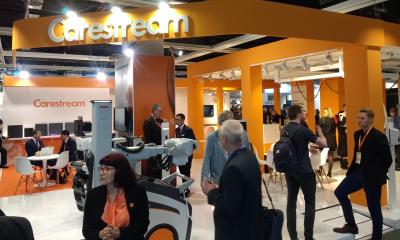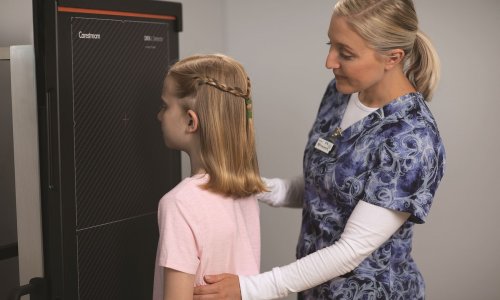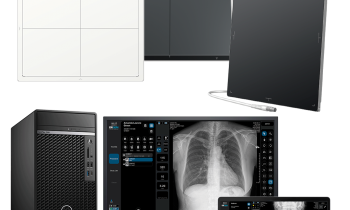The Carestream DRX-1
This September, Carestream Health revealed the first wireless cassette-size DR Detector. The Carestream DRX-1 system, which incorporates a console and wireless 14x17 inch cassette-size digital radiography (DR) detector, provides a rapid, affordable conversion for users of radiographic film or computed radiography systems, Carestream explains.

The equipment can be used with an existing wall stand or table-based Bucky, and no modifications to existing analogue equipment are needed, so installation costs are low. In addition, a healthcare facility can use one detector for almost all types of examination in which a traditional cassette would be used. ‘The Carestream DRX-1 system delivers high-quality preview images in less than five seconds, which significantly improves productivity, even for users of computed radiography (CR) systems,’ Carestream explains.
When we spoke with Todd Minnigh, Marketing Director, Carestream Health Inc, about the development of this new device, he explained that the detector used for the DRX-1 is a combination of Carestream’s research and that of a few ‘undisclosed partners’. It has a very highly active fill factor, he pointed out. ‘When you look at the individual picture, a pixel, for example, say from Canon, a certain percentage of the pixel is the active area, in other words, it can receive an image, and a certain percentage of the pixel is simple circuitry, like transistors. They manage the movement of the image information. What we have is a pixel where the entire surface of the pixel is sensitive to light, so this allows us to capture more of the light and not waste any. Then the electronics are behind the pixel. In other words, instead of having it all on one plane, or on one simple circuit, we actually have a multi-layered circuit. By doing it that way we have very, very good DQE for this type of DR technology.
‘We are able to use Gadolinium Oxysulphide (GdOS) and still get a good DQE because of the greater surface area for each pixel. The reason we use GdOS is really because of its durability. Cesium iodide (CsI) is a crystal and somewhat brittle, and to make this cassette size detector – the cassette was really a very important part of the design – we needed to start out with a fundamentally durable detector material – scintillator and detector material. These two things were important for the first attempt at making such a thing.
‘The development of such a neat concept began with core research labs’ investigation over seven years ago’, Todd reflected. ‘Commercialisation of the product goes back about three years. A long time, but this is very advanced technology. As far as we know no one else has a cassette size, wireless DR. It really is a technological breakthrough. If you look at the market, about 93% of X-ray rooms are currently cassette-based. We say, well of course, they were built around a standard and that standard was the film cassette which later became the computed radiography (CR) cassette, using the same standard. So if you could make a DR cassette at that standard, you would have a really nice solution because you could simply put it in and it would fit, and then the room would be converted to a DR room and a great deal of the workflow would improve because the movement of cassettes would be almost eliminated. Essentially, it takes away the obstacles to converting to DR.’
The current wireless design, he pointed out, is for use in an X-ray room. ‘The console is associated with this X-ray room and can work anywhere in it. This 802.11n wireless technology with the WPA2-PSK security software ensures that information is communicated peer to peer, and only between the cassette and console. So, if you were to use this technology in a typical application, it works for many metres. In our clinical tests we have had no issues with it communicating from anywhere in the X-ray room.’
There is yet another special feature of the DRX-1. Todd Minnigh explained that the lithium ion battery has a certain polymer layer and is ‘… a bit like a very large cell phone battery. The technology that keeps my cell phone working all week will keep my X-ray detector working all day. It can run for 70 to 90 exposures. We assume this will be in a typical busy setting, but even if not, the battery will stay charged for several days. Most examinations have 2–3 views. In an extremely busy X-ray room, 50 or 60 examinations may take place daily, meaning very close scheduling and only 2–3 battery changes through the day. It only takes about 30 seconds to swap to another battery. The first is then recharged in about three hours. The charger holds up to three batteries so you can use the detector constantly, all day long. It is almost impossible to shoot enough pictures to use up all of the batteries in the time it takes to recharge them. There are some wireless detectors, which are not cassette size and their batteries don’t come out. So you have to take the whole detector and put it in a charger stand to recharge; I don’t know how long their batteries take to charge.’
The detector, case and components are rugged, yet the detector weighs just 8.5 pounds – up to 30% lighter and some 50% smaller than other portable detectors.
Carestream points out that it is suitable for general radiology, trauma, orthopaedics and almost all other X-ray examinations, adding that the system’s console assists with image capture, preparation of preview images, image processing and full-resolution display. Images can be transmitted as DICOM files to a PACS or storage device.
All in all, a very neat package, so how has it been received? Todd Minnigh said that the Carestream DRX-1 has already been on show privately to customers at a few trade shows. ‘The response has been really wonderful. The general customer reaction has been: This is the solution I’ve been looking for. So it’s wonderful to have something that your competition doesn’t have, and that the market is hungry for. We are solving a real problem in healthcare, at least in the small area of X-ray, a core modality for us.’
The future market for this wireless, lightweight X-ray equipment is indeed large. ‘Globally there are over 200,000 X-ray rooms. If you count veterinary applications and others you can go over 300,000, but core hospital X-ray rooms alone are over 200,000, and 93% are cassette based,’ he pointed out. ‘Over the next 15 years as the baby boomers retire, most developed countries, as well as others, will have approximately twice as many patients, yet proportionally fewer workers. Then, it’s not just about who will pay for healthcare, but who will shoot the X-ray?’
28.10.2008











